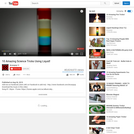
very usefull to understand liquid
- Subject:
- Applied Science
- Material Type:
- Lesson
- Date Added:
- 02/01/2016

very usefull to understand liquid
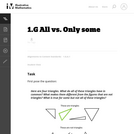
This is a task from the Illustrative Mathematics website that is one part of a complete illustration of the standard to which it is aligned. Each task has at least one solution and some commentary that addresses important asects of the task and its potential use. Here are the first few lines of the commentary for this task: First pose the question: Here are four triangles. What do all of these triangles have in common? What makes them different from the figures that are no...

These active process-oriented lessons focus on concepts of line direction and type, organic shape, 3-D form, real and implied texture, secondary color, and principles of composition. Literacy-infused lessons explore text direction/spacing, observation, description, and story elements through drawing, painting, collage, clay modeling and printmaking.
The K-6 lesson handbooks were originally produced for the Lake Washington School District with grants from 4culture and ArtsWA. Encourage your colleagues, other schools, and organizations to use these materials for non-commercial, educational purposes at no cost by downloading their own copy at: http://artsedwashington.org/portfolio-items/alic-2

OverviewThe purpose of Thinking Big is to immerse students in a series of research-based cognitive behaviors that are foundational to school and life success: creativity, logical reasoning, memory, and spatial reasoning.Thinking Big was developed by Frederick County Public Schools and is made up of single-day experiences designed to instruct students in the behaviors and elicit them without additional prompting. While arranged in order of difficulty, lessons may also serve as “stand-alone” experiences throughout the year grouped by cognitive focus. Most lessons use mathematical thinking prompts and manipulatives. The focus of the unit is not on math, but on thinking and reasoningThe lessons have also been mapped to the relevant gifted behaviors that are taught and observed through the PTD Program. There are two scoring guides: one that allows the observer to record the names of those students who exhibit a command of the cognitive behavior(s); and a REPI-aligned continuum, which allows the observer to note the affective behavior that undergirds a student’s high-level completion of the cognitive behavior. This module is meant for all students. The classroom teacher should work with a specialist or special educator to find or develop alternate activities or resources for visually-impaired students, where appropriate.
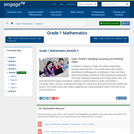
In Module 5, students consider partwhole relationships through a geometric lens. The module opens with students identifying the defining parts, or attributes, of two- and three-dimensional shapes, building on their kindergarten experiences of sorting, analyzing, comparing, and creating various two- and three-dimensional shapes and objects. Students combine shapes to create a new whole: a composite shape. They also relate geometric figures to equal parts and name the parts as halves and fourths. The module closes with students applying their understanding of halves to tell time to the hour and half hour.
Find the rest of the EngageNY Mathematics resources at https://archive.org/details/engageny-mathematics.

This resource was created by the Washington Office of Superintendent of Public Instruction.

(Nota: Esta es una traducción de un recurso educativo abierto creado por el Departamento de Educación del Estado de Nueva York (NYSED) como parte del proyecto "EngageNY" en 2013. Aunque el recurso real fue traducido por personas, la siguiente descripción se tradujo del inglés original usando Google Translate para ayudar a los usuarios potenciales a decidir si se adapta a sus necesidades y puede contener errores gramaticales o lingüísticos. La descripción original en inglés también se proporciona a continuación.)
En el módulo 5, los estudiantes consideran parte de las relaciones completas a través de una lente geométrica. El módulo se abre con estudiantes que identifican las partes definidas, o atributos, de formas dos y tridimensionales, basándose en sus experiencias de jardín de infantes de clasificación, análisis, comparación y creación de varias formas y objetos de dos y tridimensionales. Los estudiantes combinan formas para crear un nuevo todo: una forma compuesta. También relacionan las figuras geométricas con partes iguales y nombran las partes como mitades y cuartos. El módulo se cierra con estudiantes que aplican su comprensión de las mitades para decir tiempo a la hora y media hora.
Encuentre el resto de los recursos matemáticos de Engageny en https://archive.org/details/engageny-mathematics.
English Description:
In Module 5, students consider partwhole relationships through a geometric lens. The module opens with students identifying the defining parts, or attributes, of two- and three-dimensional shapes, building on their kindergarten experiences of sorting, analyzing, comparing, and creating various two- and three-dimensional shapes and objects. Students combine shapes to create a new whole: a composite shape. They also relate geometric figures to equal parts and name the parts as halves and fourths. The module closes with students applying their understanding of halves to tell time to the hour and half hour.
Find the rest of the EngageNY Mathematics resources at https://archive.org/details/engageny-mathematics.
![OREGON MATH STANDARDS (2021): [1.GM]](https://img.oercommons.org/160x134/oercommons/media/courseware/lesson/image/13138_ODE_Math_Logo_2018-H_color_BvjqVNy.png)
The intent of clarifying statements is to provide additional guidance for educators to communicate the intent of the standard to support the future development of curricular resources and assessments aligned to the 2021 math standards. Clarifying statements can be in the form of succinct sentences or paragraphs that attend to one of four types of clarifications: (1) Student Experiences; (2) Examples; (3) Boundaries; and (4) Connection to Math Practices.
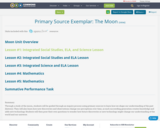
Through a study of the moon, students will be guided through an inquiry process using primary sources to learn how we shape our understanding of the past (history). They will also learn how new discoveries and observations change our perceptions over time, as each succeeding generation creates knowledge and adds new technology. Students will then pose their own questions to wonder how future discoveries or new technology might change our understanding of the world and our universe.
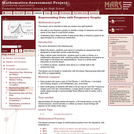
This lesson unit is intended to help teachers assess how well students: are able to use frequency graphs to identify a range of measures and make sense of this data in a real-world context; and understand that a large number of data points allow a frequency graph to be approximated by a continuous distribution.

This lesson unit is intended to help teachers assess how well students are able to interpret data using frequency graphs and box plots. In particular this unit aims to identify and help students who have difficulty figuring out the data points and spread of data from frequency graphs and box plots. It is advisable to use the lesson: Representing Data 1: Frequency Graphs, before this one.

This resource helps students better understand triangles.